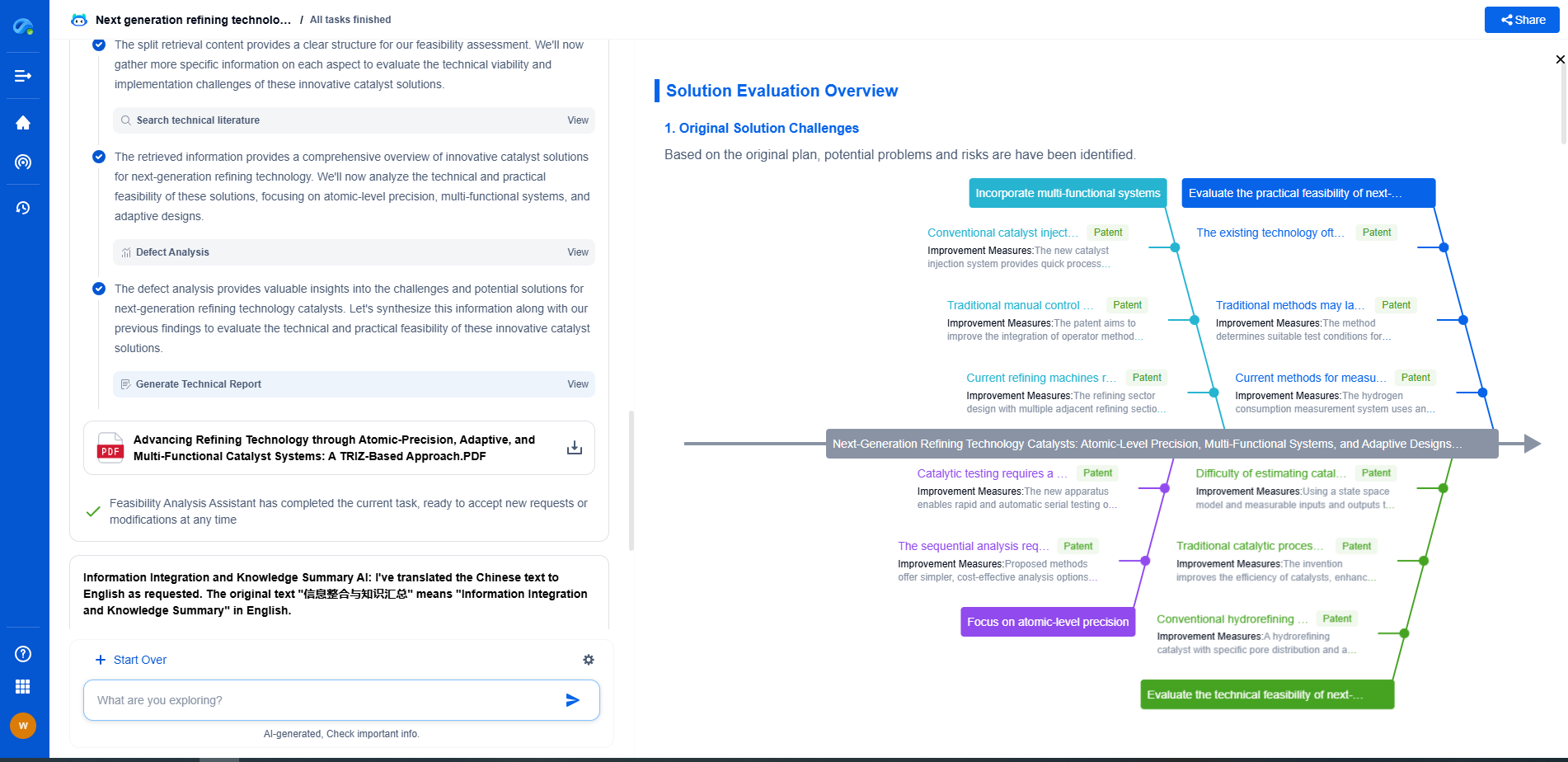MOR Spin-Coating: Solvent Selection for Uniform Films
JUL 28, 2025 |
Spin-coating is a widely used technique in material science and engineering for creating thin, uniform films over flat substrates. This method involves depositing a solution onto the center of a substrate and rotating the substrate at high speeds, causing the liquid to spread and form a thin layer. The applications of spin-coated films span various fields including electronics, optics, and biotechnology, as these films can serve as semiconductors, insulators, or protective coatings. The quality of the final film is paramount, and one of the most critical factors influencing it is the choice of solvent.
Importance of Solvent Selection
The solvent used in a spin-coating process plays a crucial role in determining the uniformity, thickness, and overall quality of the resulting film. The solvent choice impacts several aspects, including the rate of evaporation, solubility of the material being deposited, and the interaction with the substrate. An inappropriate solvent can lead to defects such as streaks, bubbles, or uneven thickness, which can compromise the film's functionality and performance.
Factors Affecting Solvent Selection
1. **Evaporation Rate**: The evaporation rate of a solvent is a key determinant of film uniformity. Ideally, a solvent should evaporate at a rate that allows for an even distribution of the coating material across the substrate. Solvents with too high an evaporation rate might cause uneven film formation due to rapid drying, whereas those with too low a rate might lead to material pooling or sagging.
2. **Solvent-Substrate Interactions**: The interaction between the solvent and the substrate surface is critical for achieving good adhesion and uniformity. A solvent that wets the substrate well will spread evenly, forming a consistent film. Conversely, poor wetting can lead to dewetting and patchy films. It’s important to consider the surface energy of the substrate and the polarity of the solvent to ensure compatibility.
3. **Solubility**: The solvent must adequately dissolve the material to be coated. Poor solubility can result in incomplete dissolution, leading to particle formation and defects in the film. The choice of solvent should therefore be guided by the chemical nature of the material to be coated, ensuring complete solubility for optimal results.
4. **Boiling Point and Vapor Pressure**: The boiling point and vapor pressure of a solvent influence the drying dynamics during spin-coating. Solvents with too low a boiling point might evaporate before a uniform film is achieved, while those with a high boiling point may not evaporate sufficiently quickly, leading to thick films. Balancing these properties is essential for achieving the desired film thickness and uniformity.
Common Solvents Used in Spin-Coating
Several solvents are commonly used in spin-coating due to their favorable properties.
- **Toluene**: Known for its intermediate evaporation rate and good solubility for many organic materials, toluene is often used for spin-coating polymer films.
- **Acetone**: With a high evaporation rate, acetone is useful for applications requiring rapid film formation but may pose challenges in achieving uniformity.
- **Chlorobenzene**: Offering a slower evaporation rate, chlorobenzene is suitable for applications where more controlled film formation is needed.
- **2-Propanol (IPA)**: Often used for its excellent wetting properties, IPA is ideal when substrate adhesion is a concern.
Optimizing Solvent Mixtures
In some cases, a single solvent may not provide the desired properties, and mixtures of solvents are used to tailor the evaporation rate and solubility characteristics. By adjusting the ratio of solvents, it is possible to fine-tune the dynamics of the film-forming process to achieve superior uniformity and thickness control.
Conclusion
The choice of solvent in spin-coating is a critical decision that impacts the quality and performance of the resulting film. By considering factors such as evaporation rate, solvent-substrate interactions, solubility, and boiling point, researchers and engineers can optimize their spin-coating processes for uniform and defect-free films. Experimentation and adjustments to solvent mixtures may further enhance film quality, paving the way for advanced applications in various high-tech industries.
As photolithography continues to push the boundaries of nanoscale patterning, from EUV and DUV advancements to multi-patterning and maskless lithography, innovation cycles are accelerating—and the IP landscape is becoming more complex than ever.
Patsnap Eureka, our intelligent AI assistant built for R&D professionals in high-tech sectors, empowers you with real-time expert-level analysis, technology roadmap exploration, and strategic mapping of core patents—all within a seamless, user-friendly interface.
Whether you're optimizing lithography depth of focus or exploring new materials for sub-3nm nodes, Patsnap Eureka empowers you to make smarter decisions, faster—combining AI efficiency with domain-specific insight.
💡 Start your free trial today and see how Eureka transforms how you discover, evaluate, and act on innovation in photolithography—from idea to impact.
- R&D
- Intellectual Property
- Life Sciences
- Materials
- Tech Scout
- Unparalleled Data Quality
- Higher Quality Content
- 60% Fewer Hallucinations
Browse by: Latest US Patents, China's latest patents, Technical Efficacy Thesaurus, Application Domain, Technology Topic, Popular Technical Reports.
© 2025 PatSnap. All rights reserved.Legal|Privacy policy|Modern Slavery Act Transparency Statement|Sitemap|About US| Contact US: help@patsnap.com

